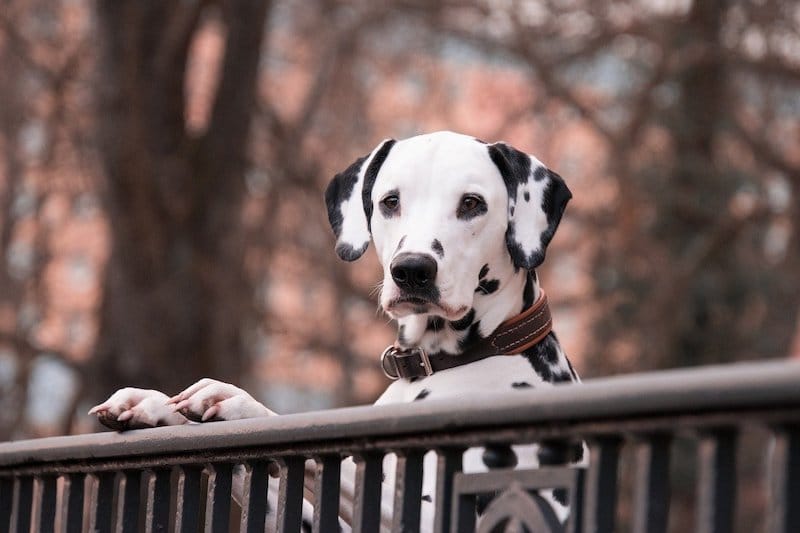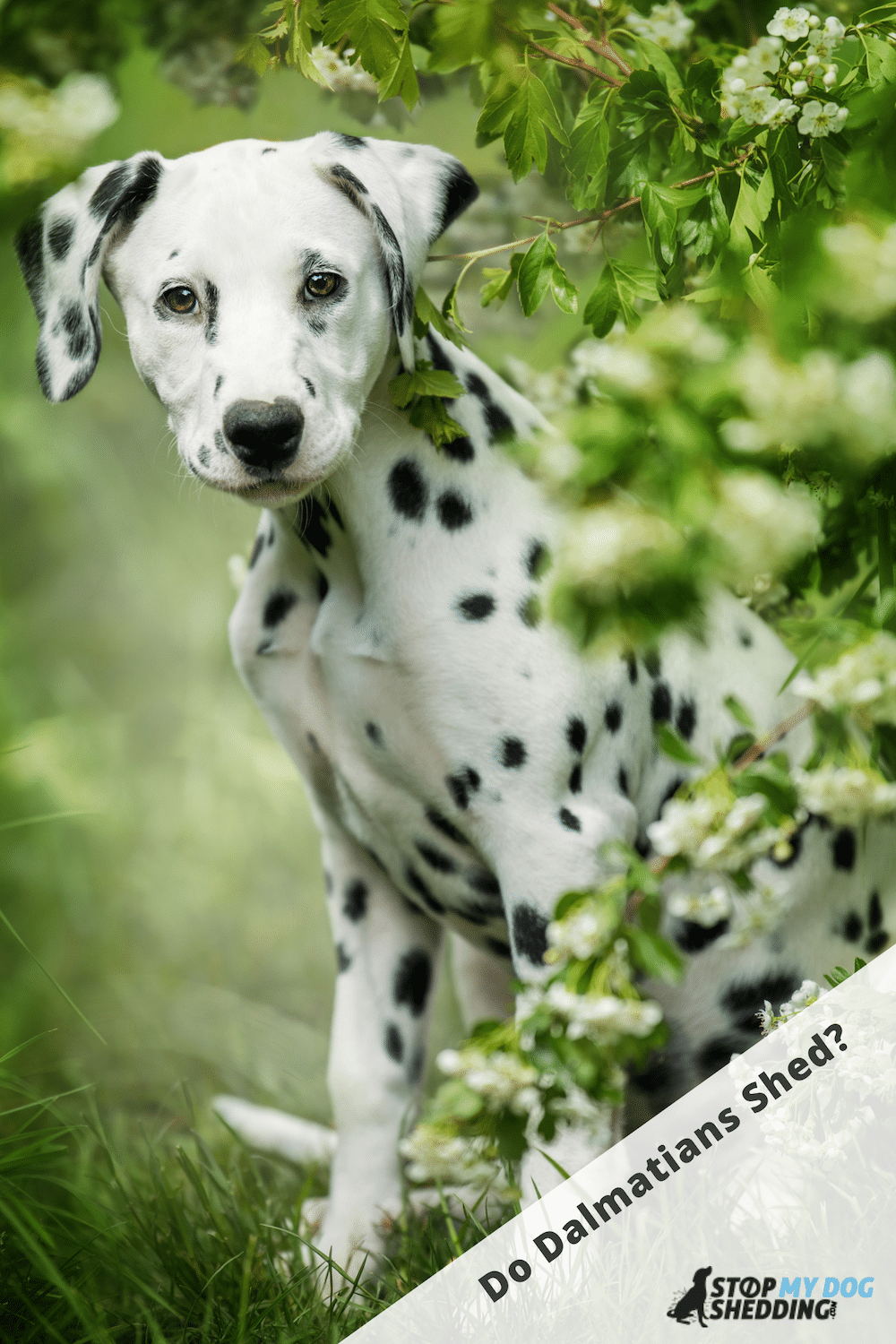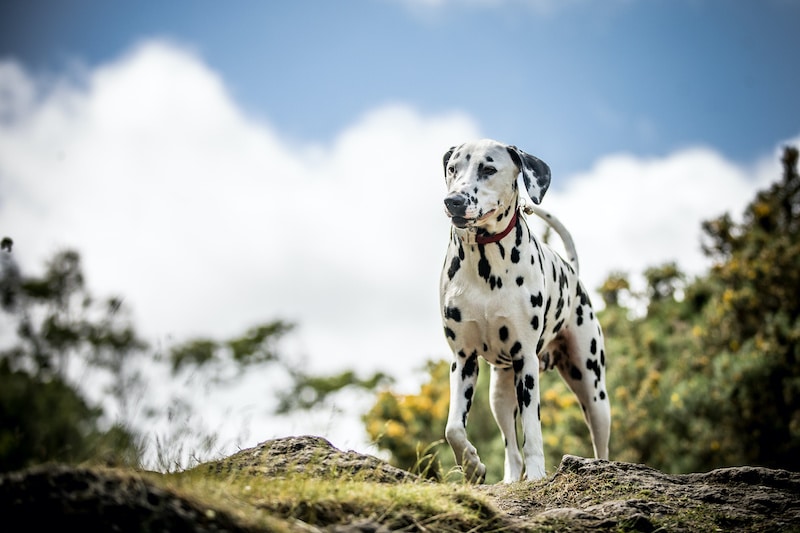Dalmatians are large dogs that are famous for their white and black spotted coat and noble job as coach dogs. But let’s be honest… most of us know them for their role in 101 Dalmatians!
And yes, they do shed lots.
Dalmatians have short, dense coats that shed heavily year-round. And the hair they drop tends to needle itself into carpets and fabrics, so it’s not very easy to remove. However, managing the shedding isn’t difficult, it mostly comes down to proper grooming, which is easy with a Dal.
Read on to learn more about how much these beautiful spotted dogs molt and what it takes to maintain their coat and keep the shedding to a minimum.
Dalmatian Shedding
Dalmatians are a heavy shedding breed.
You may not think so, given they have such short coats and given how cute and cuddly they are. But make no mistake, they shed lots!
On the plus side, the molting isn’t as noticeable as thick, double-coated dogs like the Alaskan Malamute. Dogs like this have profuse, wooly coats, and when they molt – it fills garbage bag after garbage bag. And tends to float around the home given how fine it is.
Whereas the shedding isn’t quite as noticeable with a Dal. Because while they do shed heavily, they only have one layer of short fur, and instead of “blowing coat” seasonally, they tend to shed more consistently throughout the year.
This puts them in a similar category of shedders to other large, high-shedding dogs with short hair, like the Bloodhound, for example.
However, because the Dal’s fur is so short and stiff, it tends to needle into upholstery and carpet a lot easier. So when they drop fur it may not be as noticeable as dogs with thicker, woollier coats. But cleaning the hair up off of the floors and removing it from furniture and clothing can be time-consuming.

Why do they shed so much?
How much any dog sheds mostly comes down to the individual breed. Put simply, some dogs shed more than others. But to give you a more detailed answer, it depends on a variety of factors, the main ones being the hair growth cycle of the dog, the time of year, and what you’re feeding them.
Here’s a quick breakdown of each of these:
- The hair growth cycle is simply about how long it takes for a dog’s fur to progress through its natural cycle of growth (anagen), rest (catagen), and falling out, to be replaced by new hair (telogen).
- Some dogs shed seasonally, for example, during spring and fall, while others (like Dals) shed constantly throughout the year.
- What you feed your Dal can have an impact on his overall health and the condition of his coat, which in turn can impact how much he sheds.
There are other factors that can cause shedding too, or at least how noticeable it is.
For example, dogs with longer, curly coats tend to trap the hairs they drop within the coat. Whereas when dogs molt short, straight hair it tends to drop right off of them.
And in some cases, the shedding can be caused by things such as stress, poor diet, fleas, and allergies, among others. Which can be hard to determine given they shed so much “normally.” So, if you have any concerns whatsoever, contact your local veterinarian. This is the safest thing to do if you’re concerned the shedding isn’t normal.
Recommended: Go here to see our top-rated dog hair blow dryers
Grooming Your Dalmatian
Grooming a Dalmatian is fairly easy.
Dals have short, dense coats with fine hair that commonly comes in white and either black or liver spots. They are large dogs, so it will take longer to brush and bathe them compared with dogs like the Boston Terrier, but overall there’s not much to it.
Brush them once or twice per week with a stiff bristle brush or rubber brush. Both of these are ideal for dogs with short coats and are not expensive or difficult to use.
Optionally, if you want to remove more dead fur in less time, it may be worth using a de-shedding tool. However, it’s important to avoid over-brushing, especially with a de-shedder, as this can cause skin irritation which in turn can lead to excessive shedding.
When it comes to bathing, they’re not very smelly dogs, and they don’t drool very much either. Not to mention, their coat tends to repel dirt and debris. So they really only need the occasional bath, like once every few months or so.
Similar to brushing, this isn’t something you want to overdo. Because bathing too often, while it can help remove the old hair, can dry out his skin. This is also why it’s worth using a good dog shampoo that doesn’t strip the natural oils from his coat.
Aside from bathing and grooming, regular care involves things like trimming his nails and cleaning his teeth and ears. Overall though, Dals are very low maintenance.
Are Dals Hypoallergenic? (Nope)
No. Dalmatians are not a hypoallergenic dog breed because their coat produces dander (dead skin), and they shed heavily. There’s no such thing as a completely non-allergenic dog anyway, but some dogs are more suitable for allergy sufferers than others.
So if you’re looking for a low shedding, hypoallergenic dog breed, the Dal isn’t it. Instead, consider a dog like the Poodle or Basenji.
How to Reduce Excessive Shedding
Almost all dogs shed, there’s no getting around it. And since shedding is a natural, normal process that virtually every dog goes through, it is not possible to stop it.
However, you can minimize excessive shedding, and you can learn to manage the situation so that less of the dog’s fur ends up falling onto your floors, furniture, and anywhere else your dog wanders.
How?
Well, for the most part, it comes down to grooming and nutrition:
- Grooming: Brushing your Dal regularly with a rubber or bristle brush can make the world of difference. Not just because it removes the fur before it drops off of him, but because it helps distribute his skin oil. So brushing can help both prevent excessive molting and reduce how much of it gathers around the home.
- Nutrition: What you feed your Dal can also make a big difference. Feeding him high-quality, balanced dog food can improve his overall health and the condition of his coat. So it pays to speak with your vet about selecting the best possible food. It may cost a bit extra, but this could save you some time vacuuming.
There are some other effective ways to manage shedding. Like bathing with a high-quality, moisturizing dog shampoo. Or using natural supplements (such as those that contain Omega-3) that improve his skin and coat.
It may also be worth investing in a good quality vacuum cleaner designed for removing pet hair. Or at the very least, an attachment for your existing vacuum. Because if you’ve ever lived with a short-haired shedder like the Dal, you’ll know that regular vacuums simply don’t cut it. This one thing alone can save you a ton of time.
In any case, when it comes to managing the molting, simply grooming him properly and making sure his diet is optimal can go a long way. You are still going to notice some fur floating around, this is to be expected with such a heavy shedder.
But if you love the idea of adopting a Dal, don’t let this put you off. Dals are an amazing breed, and by simply incorporating these tips into your routine, you can keep it under control.













Please note: By submitting a comment using the above comment form, you confirm that you agree with the storage and handling of your data by this site as detailed in our Privacy Policy.